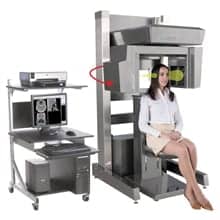 St Mary’s Hospital had been wrestling with safety concerns associated with hand-loaded injectors before choosing to use prefilled syringes. St Mary’s Hospital had been wrestling with safety concerns associated with hand-loaded injectors before choosing to use prefilled syringes. |
The benefits of using prefilled syringes were unknown to the CT team at St. Mary’s Hospital in Passaic, NJ, until about a year ago when a vendor’s sales representative made a visit to the 150-bed facility to demonstrate the product.
That presentation could not have come at a better time. The enterprise had been wrestling with safety concerns involving the hand-loaded injectors that previously were the CT division’s standard for contrast bottle-to-syringe transfers.
“We became aware that there was a risk of air infiltration with our old injectors,” says Tom Dross, RT, assistant chief technologist in the hospital’s radiology department. “There was no way to ensure that a syringe inadvertently left on the injector by someone from the previous shift was in fact new and unused. We asked ourselves, what would happen if a technologistat the start of the next shift and working alonewas in a rush and found a syringe on the injector? Would he be so distracted by being in a hurry that he would unthinkingly assume it was a new syringe? Our fear was that it would turn out to be an old, used syringe and that, yes, he might mistake it for a new one and then proceed to load it up with contrast. The result of that would be air inside the syringe, which then would be injected into the patient, a worst-case disaster.
“When we were shown the prefilled syringes, we recognized that converting over to these would completely eliminate the potential for such a scenario. The way these prefilled syringes are designed, once you’ve depressed the plunger completely, that’s the end of itin the fully advanced position it locks in place and there’s no way to use it a second time. We saw that as a tremendous safety feature.”
The hospital subsequently discovered other reasons to be enthusiastic about prefilled syringes, not the least of which was the savings in technologists’ time.
“Previously, it took about 3 minutes to load a syringe,” Dross figures. “You had to take a bottle of contrast from the warmer, place a sterile syringe on the injector, insert into the contrast bottle, advance the plunger, then pull back and load the contrast. Also, you had to take time to make sure you had loaded the precise amount of contrast.
“The prefilled syringes eliminate three of those steps, which cuts about 2-and-a-half minutes from the entire process. That reduction may not seem like it would count for much, but when you add up those few minutes over the course of a typical day in which we’ll perform maybe 12 CT studies, you’re talking about saving a full half-hour of labor time.”
Understandably, the prefilled syringes proved popular with the CT technologists from the beginning. “It represented a small convenience in the big scheme of things, but the technologists clearly appreciated it,” Dross comments.
However, old-style syringes haven’t been fully supplanted by the prefilled type. St Mary’s still must perform its own loading in a handful of angiogram studies that require more contrast than contained in the largest-size prefilled syringe.
“The biggest ours come in is 150 ml,” Dross explains. “For an angiogram with a runoff study, we really need 200 ml.”
St. Mary’s recently replaced its lone CT scanner with a state-of-the-art, high-speed model. Dross thinks the addition of this new equipment will help the hospital attract more CT business in the near-term.
“This is a competitive market,” he says. “There are three other hospitals here that also offer CT services. By updating our CT capability, it’ll keep us in the running.”
And by modernizing its contrast injection process with prefilled syringes, the competitive edge St. Mary’s enjoys is now just that much sharperand safer.



